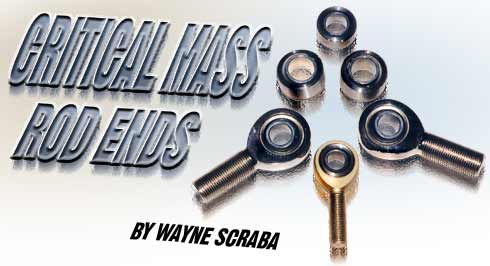|

Part 2
6/7/04
Last issue, we began
our look into rod ends or spherical bearings.
Truthfully, rod ends are one of those "install
and forget" components. Unfortunately, that
isn't right. They're extremely important pieces
of equipment in your racecar chassis, and if
just one rod end fails in a critical location,
you could have more than your hands full. This
issue, we'll take a look at rod end materials,
sizes and installation practices. Let's begin
with the "clock":
Clocking Rod Ends
When a pair of rod ends are used in one component (such as a four link bar), the orientation of the rod ends on either end is important. This is called "clocking". But before we examine clocking, we should point out that even very small adjustments in any suspension link that sees pre-load can make a large difference in the way the car handles. In some cars, one-sixth of a turn at a time is sufficient to see a change in the behaviour of the chassis. Because of this, it's a good idea to use the "flats" (flat sides) of the jam nuts as a reference point for adjustment.
Here's how this small adjustment process works: In illustration 1 (courtesy Jerry Bickel Race Cars), you can see how a typical link is configured: One side is equipped with right hand threads while the other end of the link is equipped with left hand threads. By loosening the jam nuts, you can lengthen or shorten the entire link.
What about clocking? It's easy. Check out illustration 2 (courtesy Jerry Bickel Race Cars). As you can see, when the rod ends are properly "clocked", then they're aligned. This prevents binding of the suspension, and makes it easy to determine if the link is under tension by "feel". If you grasp the link by hand, and rotate it back and forth, you can tell if the link is neutral or under strain.
Size Matters
Aside from misalignment, there are other things
to consider when selecting a rod end for a given
application. From a dimensional perspective,
a rod end is typically constructed two ways.
The first type has a shank (the threaded segment)
that is exactly the same diameter as the hole
in the ball (as an example, a 3/4-inch bore
coupled with a 3/4-inch shank). The next type
has a shank that is one size larger than the
bore (a good example is a 5/8-inch bore mated
to a 3/4-inch shank). The second type (smaller
bore, larger shank) has an advantage, especially
where bending loads may be present. A good example
is a Pro Stock style four link. In this case,
we have two pairs of tubular bars acting as
levers, transmitting considerable forces from
the chassis to the tires (and vice-versa). In
this type of application, the larger shank provides
more strength along with a considerable amount
of reserve strength capacity. In construction,
an oversize shank is generally made by installing
an insert one size smaller in the body of the
part with the larger shank. Because of this,
a 5/8-inch X 3/4-inch rod end will exhibit higher
load capacities than a 3/4-inch X 3/4-inch rod
end, provided both are manufactured from similar
materials. This is due to the fact there is
more body material around the insert. You'll
also find asymmetrical rod ends such as this
provide superior wrench access on many suspension
components. Why? The fastener that goes through
the center of the rod end is smaller. There
is one exception to the above oversize shank
construction scheme: Some companies offer a
rod end where a larger shank is added to a smaller
body. While this configuration serves the same
purpose as the oversize shank situation mentioned
above, it provides less meat around the rod
end ball (simply because there's less material
surrounding the spherical bearing).

|